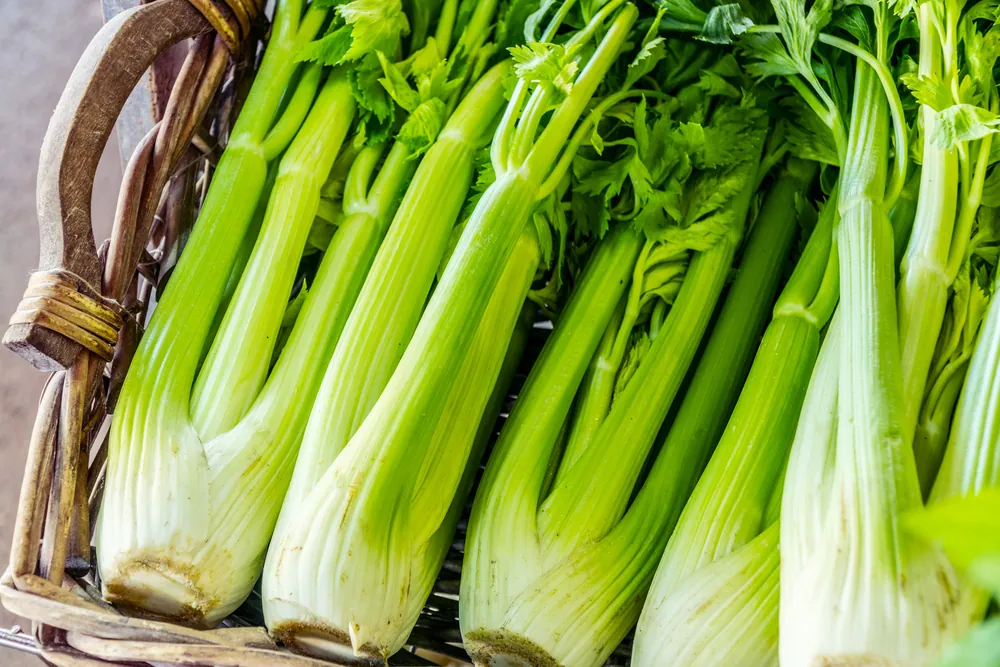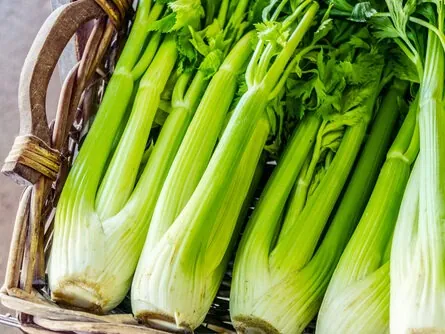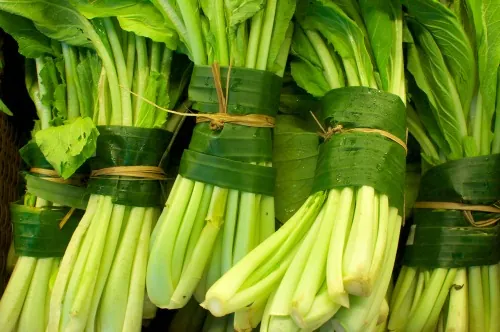Since about 1623, celery has been used as a typical cooking ingredient, either eaten raw in vegetable dishes or cooked in soup and stew. It was first introduced to America during the 1800s in Michigan, and since then, it has further spread around the country. Thanks to the ongoing cycle of importing and exporting, celery is always available for convenient year-round purchasing. On average, an American consumes about 6 pounds of celery over a single year.
What Is Celery?
Celery(Apium graveolens) is a crisp water-infused vegetable part of the Apiaceae family, which includes carrots, parsnips, and parsley. It is a marshland plant of long green fibrous stalks; its color determines its flavor. A pale stalk means less bitterness, and a darker stalk means more. Celery was first cultivated in the Mediterranean Region about 3000 years ago and has spread worldwide since then. Raw, cooked, or juiced celery is consumed in many different forms and remains famous for its unique crunch, flavor, and nutritional properties.
Types Of Celery
There are main types of celery all over the world. The three main types are:
- Celeriac
- Grown mainly for its root.
- Also known as a root vegetable.
- It takes 100 to 120 days to mature.
- Grown primarily in Europe and the Mediterranean Basin.
- Some varieties include:
- Diamant Celery
- Tellus Celery
- President Celery
- Marble Ball Celery
- Brilliant
- Giant Prague Celery
- Leaf Celery
- Grown mainly for its leaves and seeds.
- Also Known as Cutting Celery, Smallage, Chinese Celery, and Nan Ling Celery.
- It takes up to 140 days to mature.
- Mainly grown in East Asia.
- Some varieties include:
- Par-Cel Celery
- Safir Celery
- Flora 55 Celery
- Pascal Celery
- Grown mainly for its stalk.
- Also Known as Stalk Celery.
- It takes 105 to 130 days to mature.
- Grown primarily in the United States.
- Some varieties include:
- Giant Red Celery
- Conquistador
- Golden Boy Celery
- Tall Utah
- Golden Pascal Celery
- Monterey Celery
-
Top 10 Celery Importers (2020)
- United States ($70.9M)
- Canada ($70.9M)
- Germany ($32M)
- UK ($25.2M)
- Netherlands ($13.1M)
- Russia ($11.3M)
- France ($11.2M)
- Malaysia ($8.28M)
- Belgium ($6.84M)
- Poland ($5.94M)
-
Top 10 Celery Exporters (2020)
- Spain ($96.7M)
- United States ($84M)
- Mexico ($71.5M)
- China ($17.2M)
- Italy ($13.4M)
- Netherlands ($10.5M)
- Israel ($10.5M)
- Australia ($6.38M)
- Germany ($4.66M)
- United Kingdom ($3.01M)
Maintaining Celery Year-Round
Drought Prevention
The amount of water a celery field receives determines the quality of the final product. Depending on the crop size, this vegetable can be very demanding on its local water supply. States that experience droughts are less likely to farm such a water-intensive vegetable than those that don’t. Without proper growing conditions and care, celery stalks can become stringy and dry, making them undesirable in a market environment. In conclusion, the more water there is available, the more successful your celery crop will be.
Temperature Control
Even though celery can be grown year-round, quality and quantity vary each season. Celery requires a longer growing season than most other produce and prefers cooler temperatures. Celery does best in places with temperatures of 60 and 70 degrees Fahrenheit during the day and no lower than 50 degrees at night. In the US, the best time of year to sell or buy celery is during late spring or fall. During these months, the stalks are extra fresh and crispy.
Harvesting and Packaging Celery Year-Round
Even though celery is grown year-round in the US, it is a challenging vegetable to maintain because of its high demands and specific growing requirements. Ideal growing conditions include rich soil, cool weather, and a consistent water supply. California takes the lead in producing most of this crop since the above conditions are found in various districts. Celery is harvested once the overall yield has reached the ideal marketable size, about three to six months after planting. Next, the leaves are trimmed, and the harvest is sorted by size. Celery is generally packed and shipped in film packaging within wax cartons.
When shipping produces such as celery, specific requirements must be met. The product must be handled carefully and should not be stacked more than four high when stored or transported. Usually, celery is packed upright in either crates or cartons. The conditions celery requires include a temperature of about 34 degrees Fahrenheit and 85 percent humidity. A Reefer could accommodate the ideal temperature and moisture necessary for the journey. A temperature control truck is highly recommended when transporting fragile produce such as celery. This is the best way to avoid any loss of quality during transit.
Shipping Celery Year-Round With FreightCenter!
Have trouble finding a way to ship produce? Let FreightCenter help! We’re experts when it comes to shipping products both nationally and internationally. Our carriers and freight agents can ease you into the process to ensure it’s a smooth ride for both you and your shipment. Use FreightCenter’s free online quote tool to begin. Call our shipping experts at 800.716.7608.
[rank_math_html_sitemap]



